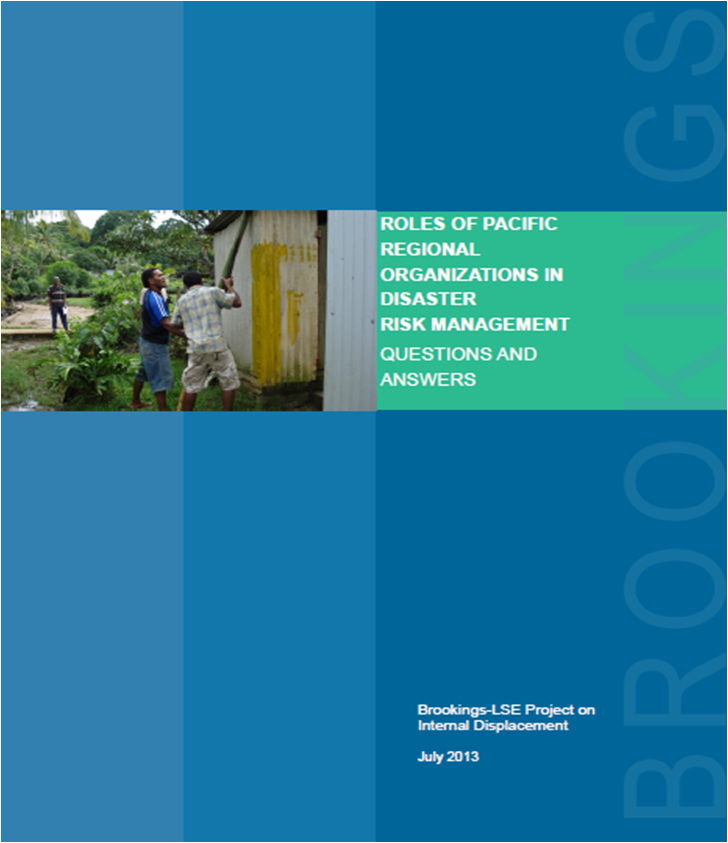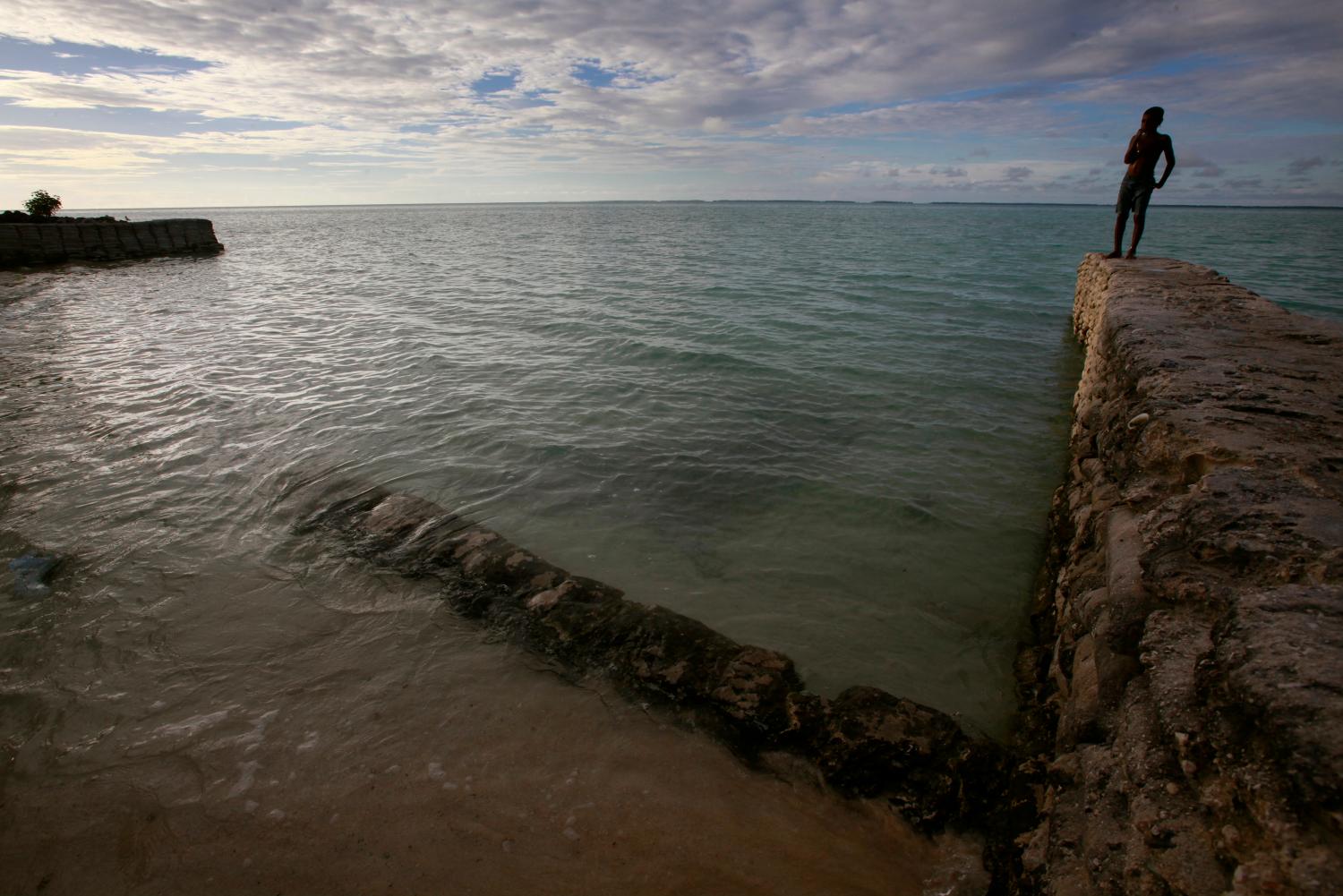 Although regional mechanisms are playing increasingly important roles in disaster risk management (DRM), there has been remarkably little research on their contributions and few published studies on their comparative advantages. At a global level, a recent Brookings study sought to address this gap by summarizing the work of more than thirty regional organizations involved in DRM, drawing some comparisons and generalizations about the work of thirteen in particular. The present study also seeks to address the gap through an in-depth assessment of the Pacific islands region.
Although regional mechanisms are playing increasingly important roles in disaster risk management (DRM), there has been remarkably little research on their contributions and few published studies on their comparative advantages. At a global level, a recent Brookings study sought to address this gap by summarizing the work of more than thirty regional organizations involved in DRM, drawing some comparisons and generalizations about the work of thirteen in particular. The present study also seeks to address the gap through an in-depth assessment of the Pacific islands region.
The report documents the current contributions of Pacific regional organizations to DRM and explores the potential for them to play more substantial and active roles in the future. This involves consideration of the expectations and directives of the governing member countries of these Pacific Regional Organizations (PROs), their comparative advantage over other DRM mechanisms, and their capacity to provide such services. The findings led to the identification of good practices for DRM at the regional level. They were also used to determine where, within the DRM space, PROs are best placed to work, and how their current contributions might best be strengthened in order to realize their full potential as key players in DRM for the Pacific islands region. Regional cooperation in the Pacific began immediately after World War II, when the region was almost wholly made up of dependent territories. A historical perspective on regionalism in the Pacific is extremely important for understanding the current and future roles of PROs in DRM.
At the regional level, the mandate for the overall coordination and monitoring of DRM activities currently rests with the SOPAC Division of the Secretariat of the Pacific Community (SPC),[1] including responsibilities for implementation of relevant technical programs. Climate change activities in the region, and coordinated engagement in the United Nations Framework Convention on Climate Change process, are guided by the Secretariat for the Pacific Regional Environment Programme (SPREP). Political leadership and effective resourcing issues are generally led and coordinated by the Pacific Islands Forum Secretariat (PIFS). Practical application of adaptation and mitigation activities across many key development sectors is led by SPC, and on some issues by SPREP, while research and development, including human resource development, are led by the University of the South Pacific. Other agencies within the Council of Regional Organizations of the Pacific focus on particular sectors, covering the specific impacts of climate change on these sectors and mainstreaming these into their responses. This includes the Pacific Islands Forum Fisheries Agency (PIFFA) on pelagic fisheries, the South Pacific Tourism Organization covering tourism, the Pacific Power Association (PPA) with power utilities, and the Fiji School of Medicine on health issues.
In addition to the growth of Pacific regional intergovernmental organizations, non-governmental organizations (NGOs) operating nationally and regionally have also grown in size and in number. The Pacific Islands Association of Non-Governmental Organizations (PIANGO) was formally established in 1991 to assist Pacific NGOs to initiate action, to give voice to their concerns and to work collaboratively with other development actors for just and sustainable human development. PIANGO supports a regional network of NGO focal points or coordinating bodies based in 21 Pacific Island countries and territories. Within this network, specific Pacific Regional Non-Governmental Organizations (PRNGOs) meet regularly to discuss issues of common concern.
Regional Organizations and DRM. Only one intergovernmental regional organization (the SOPAC Division of SPC) has a program devoted to DRM. On the other hand, there are two non-governmental organizations (Foundation of the People of the South Pacific International and the Pacific Disaster Center) with such programs. Additionally, many regional bodies that were not established primarily as DRM mechanisms are now playing increasingly important roles in disaster risk reduction (DRR) and disaster preparedness. Thus many PROs, other than those named above, have initiatives that consider DRM – usually DRR specifically – within a broader context of climate change. And though the remainder of the PROs may not even mention DRM or climate change explicitly in their work programs and descriptive materials, the available documentation indicates, usually through references to development challenges, that such topics may well be addressed through their activities.
Comparative Advantages. Despite the fact that most PROs do not have a specific focus on DRM, they do have significant comparative advantages in some aspects of DRM, both individually and collectively. The sources of their comparative advantages are diverse and include: political convening power through strong links with the region’s leaders; key coordinating roles at the regional level; information management and dissemination through portals; provision of education, training and applied research; faith-based perspectives and actions in DRM; representatives of, and advocates for, vulnerable groups (e.g. women, disabled, youth); and their extensive and broad regional experience.
Capacities. The capacities of PROs are currently restricted to certain aspects of DRM, notably disaster risk reduction (DRR) and aspects of disaster preparedness. As indicated in the table below, PROs do not have a comparative advantage, or any tangible capacity, in either disaster relief or recovery, except for the incorporation of approaches such as “build back better” into recovery efforts when disaster risk assessments and reduction of anticipated risks are part of recovery and reconstruction. PROs can add value to these international efforts by ensuring that early warnings and other information related to extreme events in the region are made widely available. In the Pacific this is especially relevant for sudden-onset events such as seismic and volcanic activity, tsunamis and tropical cyclones but also for slow-onset crises such as drought and famine. Moreover, regional organizations could play an important role in responding to smaller-scale, slow-onset events that do not trigger major media coverage or responses from international disaster relief and recovery agencies.
Future Roles, Challenges and Capacity Building.
The challenges of growing and capacity-building will become greater in the near future, as countries and other PRO stakeholders move to integrate DRR, climate change adaptation (CCA) and the reduction of greenhouse gas emissions.
The Pacific region is now at the forefront in terms of risk insurance and finance options, largely as a result of the World Bank-SPC-Asian Development Bank Pacific Catastrophe Risk Assessment and Financing Initiative (PCRAFI). It will be important for SPC to remain fully engaged in this process, and for other relevant PROs to learn from this experience as well as assist their stakeholders to explore this and other ways to reduce the immediate financial consequences of disasters.
One of the challenges facing PROs is to develop approaches which integrate climate change adaptation strategies and disaster risk reduction. In recent years, DRM and especially DRR, have been “poor cousins” to the increasingly visible efforts to respond to the impacts of climate change, often leading to tensions between agencies at regional, national and sub-national levels.
But now that countries are moving more and more to integrate DRR, CCA and climate change mitigation, PROs will be challenged to enhance their relevance, to demonstrate excellence as significant sources of technical and related assistance, and to help ensure improved alignment of international financial flows with these integrated approaches. There is also a compelling argument for relevant PROs to become even more engaged in disaster recovery, under the “build back better” imperative.
[1] The South Pacific Applied Geoscience Commission (SOPAC) was established as a PRO in 1989. In January 2011 SOPAC became a Division of the Secretariat of the Pacific Community.


